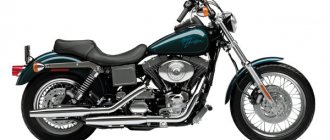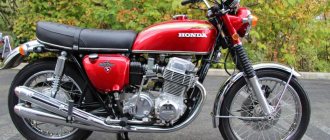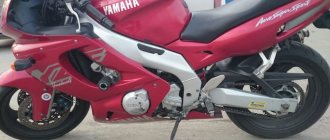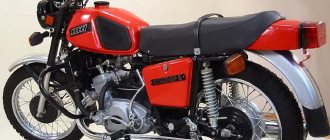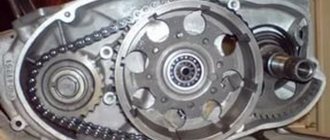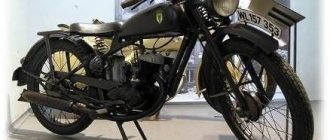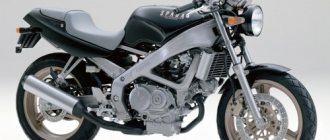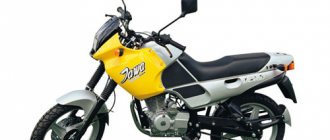Motorcycle spark plug device.
A motorcycle spark plug consists of ten main parts:
Also in this article you will find a summary table of spark plug models - model to model, for example from NGK and an analogue from Denso or NGK to spark plugs from Champion .
Spark plug characteristics
A motorcycle spark plug has a thermal characteristic, which is designated by a heat rating. The higher this number, the colder the candle.
There are two types of candle temperature:
- A hot spark plug heats up more during engine operation, since it has less heat dissipation from the central electrode and insulator. Engine oil hits the spark plug, heats up and burns quickly, but spark formation is not disrupted. Such spark plugs are suitable for low-boost engines (installed on choppers). When the heat is too strong, the oil may ignite from the spark plug rather than from a spark. Then glow ignition occurs, work stops, engine power is lost, and it may break down.
- A cold spark plug heats up less and prevents glow ignition from occurring, since it has greater heat removal from the central electrode and insulator. But since its temperature is not very high, the engine oil is not burned, which can prevent the formation of a spark. Such spark plugs are suitable for highly boosted engines in which the compression level is high (installed on sports motorcycles).
If a motorcycle spark plug often burns out, it is almost always due to the operation of vacuum carburetors.
For a low-powered engine, I recommend using hot spark plugs in cold weather, with a heat rating of 8, 11. If the engine power is 26 kilowatts and there are no good cooling conditions, and the weather is hot, then cold spark plugs with a heat rating of 14, 17 are more suitable. In winter it is better Just use candles with a protruding heat cone.
Series "K-55" and its features
The plant's design bureau carried out developments to modernize the 125th Kovrovets, and already in 1955 the first model K-55 was produced. Thanks to modernization, the speed characteristics of the Kovrovets motorcycle were increased to a maximum value of 75 km/h. The 55 was equipped with a new type of carburetor “K-55”, and the rear suspension became pendulum.
Previously, on the 125th model, the rear rigid suspension caused significant discomfort while riding and led to the need to repair the Kovrovets motorcycle (mainly the chassis). The car was equipped with a single-stroke 4.75-horsepower two-cylinder engine of its own production with a displacement of 123.7 cm³ and an improved cooling system. The motorcycle weighs, like the K-125, 84 kg. The Kovrovets motorcycle, model K-55, was produced by the plant until mid-1957.
Types of motorcycles and spark plugs
There are many types of motorcycles, each has its own motorcycle spark plug. Let's talk about them in more detail.
Izh-Planeta-5 motorcycles run on A-17B and A-11 spark plugs, but, in my opinion, with A-17B spark plugs the performance of the motorcycle improved, the idle speed became better and there were no difficulties with starting the engine.
Izh-Jupiter-5 motorcycles also run on A-17B and A-11 spark plugs, but when I installed BRISK spark plugs (Czech production), the engine worked better than with Russian spark plugs A-17B and A-11, the power of the motorcycle increased, and the amount of fuel consumed has decreased.
Tula motorcycles run on A-11 and BRISK spark plugs. I checked, A-17 spark plugs are not suitable for this motorcycle.
You can install A-14 and other spark plugs in Dnepr and Ural motorcycles. But only with A-14 candles will movement be more like flying.
For most domestic motorcycles, the best foreign spark plugs are high-quality and reliable BOSH spark plugs.
Platinum and iridium spark plugs are often used, which improve the self-cleaning ability of the spark plugs and extend their life.
For preventative purposes, I recommend changing the spark plugs of your motorcycle every spring or when the season for using other equipment (for example, snowmobiles) begins. In this case, you should not unscrew the spark plug while the motorcycle engine is still hot, as you can damage the threads in the cylinder head.
Let's summarize: when choosing spark plugs, you should take into account the type of motorcycle and the temperature of the plug, then less fuel will be consumed and the motorcycle will go faster.
The turning point 57th year
"K-55" was produced until 1957, after which another model appeared - "K-58", on which a 5-horsepower two-cylinder engine was installed, and the gas tank was enlarged. In addition, manufacturers changed its shape, which became more streamlined, and modernized the electrical equipment of the machine. The Kovrovets motorcycle (photo can be seen below) of the 58th model became the final one in the model range of 125 cc “bikes”, the production of which ended in 1960.
The production of Kovrov motorcycles of the K-175 series was launched in 1957. These were powerful road motorcycles, which, along with the 58th model, were produced by the plant until 1960. Later they were replaced by the K-175A model. The 175 series motorcycle was produced until 1965, and its prototype was the Czech model “Java-ChZ-175”. In the Soviet Union, motorcycles with a displacement of 175 cm³ had not previously been produced, so the appearance of the K-175 model on the market caused quite a stir.
The Czech “Java” at that time was the height of perfection in engineering and technical solutions, so the “Kovrovets” motorcycle turned out to be quite an interesting machine - beautiful and powerful, with excellent driving characteristics, and also very comfortable. The “K” series is completed by the “K-175V” and “K-175SM” models, after which the “Voskhod” (Kovrovets) motorcycle appeared in 1966 - a machine that was an order of magnitude more comfortable, which was distinguished by excellent technical characteristics.
What can a spark plug tell you?
Why talk about candles?
What new can I tell you about candles? nothing special. Those who are already “broken” masters in the technical zone can also teach me a lot. But the site is for everyone and there is no distribution of new and old, and I think this information will be useful to everyone. Me too.
First of all, the spark plug is an integral part of the design of a gasoline engine, without which the operation of the latter is impossible. Therefore, everything related to the spark plug in operation, starting from the moment it is installed on the engine, requires the closest attention. Secondly, the success of using a spark plug in a two-stroke air-cooled engine, where its thermal load can be higher than in a four-stroke water-cooled engine (i.e., an automobile in our reality), largely depends on the correct choice of spark plug, which again deserves detailed consideration. And finally, the condition of the spark plug makes it possible to some extent to assess the condition of the engine (especially a two-stroke engine, where the fuel is a mixture of gasoline and oil), its carburetor in particular. And this is also important. Let's start with the design of the candle:
An insulator is mounted in a steel body, which ends in a thermal cone facing directly into the combustion chamber of the cylinder. A contact rod passes inside the insulator, onto the threaded part of which a tip is screwed. The latter is usually absent on spark plugs installed on motorcycle engines. The opposite end of the rod is connected through a special glass sealant 5 to the central electrode passing inside the thermal cone. A side electrode is soldered to the end of the threaded part of the spark plug body. The connection between the spark plug and the cylinder head is sealed using a metal gasket (washer) 6. The wide variety of existing types can cause some difficulty when choosing a spark plug, especially for novice motorists.
Modification of "Kovrovets" "K-175A"
In December 1959, a fundamentally new model of the 175 was born - the “K-175A” motorcycle “Kovrovets”. The technical characteristics of modification “A” differed significantly from those of the “younger brothers”. A four-speed gearbox with a disc-type mechanism was installed on it.
The electrical equipment was based on the use of a G-38 variable generator, which made it possible to do without a battery, which was especially important for residents of rural areas, where its maintenance caused great difficulties. The front suspension, presented in the form of a rodless telescopic fork, gave the car noticeable smoothness.
The design of the air filter also underwent some changes, which began to be mounted on the suction pipe. The weight of the K-175A model is 110 kg. In comparison with the 175th modification, the power characteristics and speed capabilities remained virtually unchanged. On the gas tank of modification “A” a new emblem began to show off: two hares turned towards each other - the emblem of the city of Kovrov, and below the inscription “Kovrovets”.
Motorcycle spark plugs
We can say that a spark plug is an object that has simple functionality in a complex environment. A reliable electrical discharge must occur at the spark plug electrodes, which can reliably ignite the fuel.
Spark plug design
– The insulator is a white, shiny aluminum oxide ceramic that can withstand a melting point higher than that of steel (this part breaks if you handle the key carelessly when unscrewing the spark plug). Part of the insulator, in the combustion chamber, can heat up to 1000 degrees Celsius (with early ignition).
– Central electrode – usually consists of 2 parts. The upper one is steel, and the lower one, which we see, is made of nickel. Nickel is electrically stable and can withstand temperatures up to 1400 degrees Celsius.
– Contact stand – may have a built-in or replaceable shaped nut. Make sure it is screwed securely.
– The base is the part that has the threads that hold the spark plug in the cylinder head. The base is made of ordinary steel, and then plated with zinc or nickel.
– Ground electrode – usually shaped like an “L” at the business end of the spark plug. This area is the very place where all the latest achievements are concentrated.
Spark plug assembly technology
The candle is assembled and sealed by cold pressing. Then the side electrode is cut and bent and the spark gap is established. The plug is then tested to 8,000 psi.
You can set a different spark gap by bending the side electrode, but do not allow the center electrode to bend laterally, since this will certainly break the insulator. To do this, you can use a simple round gap gauge (feel gauge), or a piece of wire of suitable thickness.
Spark plug testing
Various standard tests are necessarily carried out on spark plugs to establish their specific characteristics and operating temperature ranges. These include the IMEP test, which measures the average effective sensitivity to high pressure, a thermal leak test, an insulator fouling test, a spark analyzer, which uses an oscilloscope to determine the degree of ionization of the spark gap, and electrode spark erosion tests to measure possible spark plug wear. All these tests are carried out only in factory conditions.
Spark gap"
The spark gap design is exactly what is most often advertised. You can find U and V-shaped grooves on the electrodes, electrodes that allow you to get a double or ring spark, a regular or lateral gap between the electrodes, a spark plug with one or more electrodes. Further on which option is theoretically correct, and whether it matters at all:
– Standard Gap: This plug can have a variety of electrodes including: full span, half span (where the side electrode is shorter and ends in the middle of the center electrode) and corner gap (where the side electrode ends at the edge of the center electrode). Racing plugs always have the shortest ground electrode and angular gap because the spark tends to jump closer to the sharp edge, and always along the path of least resistance. The lateral or angular spark gap allows you to optimize the combustion process of the mixture.
– With a protruding central electrode insulator: A spark plug of this type with an insulator protruding 5-6mm into the combustion chamber. This design prevents contamination of the insulator at low speeds, and also improves electrode cooling at high loads. It is difficult to make a plug with a protruding insulator cold due to the long side electrode, which is usually the hottest part of the plug. Besides the limited temperature range, this plug behaves as if the ignition timing had been set earlier because it sparks closer to the center of the combustion chamber.
Series of machines "K-175V"
The first models of K-175V motorcycles began to be produced in 1963, which were distinguished by the presence of a cylinder made of cast iron with one exhaust pipe. This decision was made by the plant engineers, first of all, to simplify the design and change the gear ratio, but this was not achieved.
There were no special differences in this model. The same single-cylinder 9.5-horsepower two-stroke engine, which allowed a maximum speed of up to 80 km/h and a weight of 110 kg. However, later versions already had an aluminum cylinder with two pipes for exhaust gases, which made it possible to increase the maximum speed threshold to 85 km/h. Externally, the model remained unchanged.
Replacing spark plugs on a motorcycle or car
1. In most cases, replacing spark plugs on a motorcycle or car requires a special spark plug head (with an elastic rubber insert inside or, even better, a magnetic spark plug head) complete with a ratchet drive and a device for checking and adjusting the interelectrode gaps. To safely disconnect explosive tips (“ armor ”) of wires from spark plug , a special tool is also available, although its use is not strictly necessary. Using a torque wrench will allow you to achieve the correct torque for the spark plugs in the cylinders of a motorcycle engine . 2. It is best to keep a set of replacement spark plugs with a correctly adjusted interelectrode gap your motorcycle / car When purchasing new spark plugs, make sure that they meet the parameters of your motorcycle / car . The necessary information is given in the specifications of the motorcycle / car in the book or manual. 3. Proceed to remove the spark plugs only after the engine has completely cooled down. To avoid wasting time, take advantage of the pause to check the condition of the replacement kit. Carefully inspect the new spark plugs ; if the slightest cracks are detected in the insulator, the corresponding spark plug should be rejected. Measure the size of the interelectrode gaps of the new set (see below).
4. The interelectrode gap of the spark plug is checked by inserting the appropriate meter probe into it and must meet the requirements given in the manual (technical book for the motorcycle). The probe of the required thickness should slide with slight resistance between the side and central electrodes of the spark plug . The gap can be adjusted using a special device, usually included in the meter - bend the side electrode of the spark plug accordingly.
5. If the side electrode is not positioned exactly above the center electrode, adjust its position accordingly. Make sure there are no cracks or other damage to the porcelain spark plug insulator. The presence of any kind of defects in the insulator is unacceptable.
About the Kovrovets 58th model
The maximum speed of the model reached 80 km/h with a total motorcycle weight of 92 kg. The displacement of the single-cylinder 5-horsepower engine remained unchanged. However, the shape of the fuel tank and its capacity were changed, which made it possible to increase mileage without the need for refueling. The clutch release mechanism was also modified, which made squeezing much easier. In addition, without loss of engine power, it was possible to significantly reduce noise by installing a muffler of a more advanced model.

